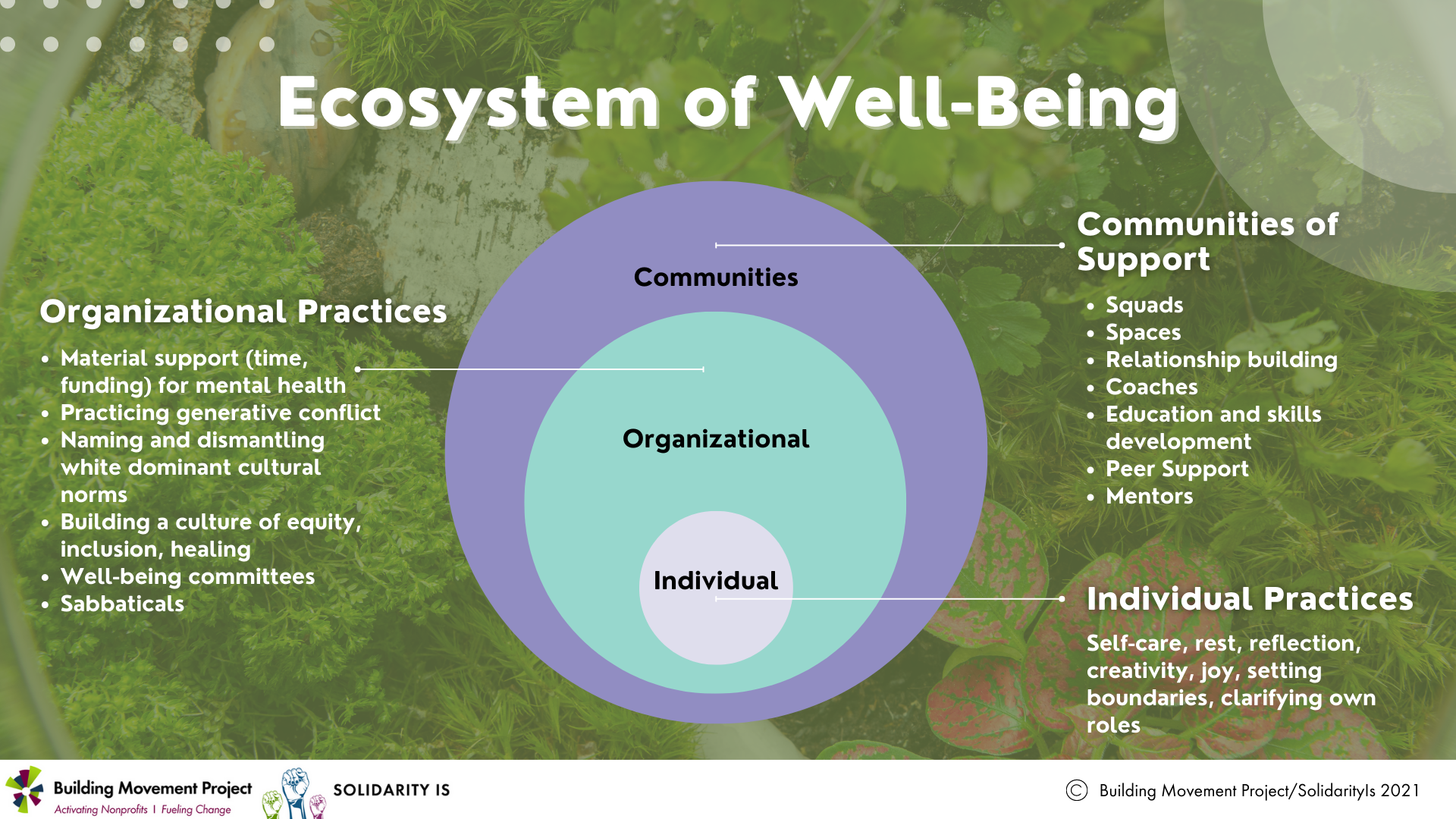This tool provides a starting point for networks and organizations to integrate self-care and community-care and sustainability practices with systemic changes.
Creating and Sustaining an Ecosystem of Well-Being
Written by UyenThi Tran Myhre (Coordinator, Movement Building)
Over the last several months, in conversations, interviews, and workshops with nonprofit and movement leaders, organizers, and community members, we have been hearing a general, collective agreement that folks are exhausted. Even as people continue to do their work, they are asking how to sustain their commitment in the midst of fatigue, vicarious or direct trauma, and hopelessness surrounding world events.
While there's no one easy answer to that question, here at Building Movement Project and SolidarityIs, we have been offering a tool called An Ecosystem of Well-Being to partner groups in trainings and workshops.
Building on the labor and wisdom of Tricia Hersey and the Nap Ministry, adrienne maree brown and pleasure activism, BATJC’s pod mapping, the framework of healing justice (and particularly this piece by Yashna Maya Padamsee on communities of care and organizations for liberation), and much more, we offer this tool as a starting point to identify how we’re already supporting each other in this work, and to experiment with new ideas and practices to sustain our commitments.
Using the Tool
The Ecosystem of Well-Being helps us visualize and create well-being as an interdependent practice, in relationship to those around us. The tool can be used to identify ways to sustain ourselves in social change work, not just as individuals, but on organizational and movement levels as well.
In the image above, we’ve included some examples of what individual, organizational, and community practices of well-being might look like. Consider these as well as the more detailed examples provided below, then download and fill out your own version of the tool. As an individual, you could use this tool by yourself to build self-awareness, or with a peer group or mentor. Members who are part of an organization or coalition could utilize this tool as part of a staff meeting or retreat.
If you work through this tool with colleagues, movement partners, peers, or in other spaces you are part of, let us know how it goes! Send us a message at solidarityis@buildingmovement.org or tag us at @BldngMovement or @Solidarity_Is on Twitter.
Cultivating Well-Being as a Practice
Individual practices
Individual well-being is about what’s right for us – and recognizing that what’s right for us won’t look the same from day to day, or even moment to moment. Individual well-being could look like making space for creativity, joy, or connection in our work and beyond. Sometimes it might be about setting and articulating boundaries about what we’re able to take on, and asking for support from others to maintain those boundaries. Maybe it’s realizing we need help, asking for it – and receiving it. It could mean identifying the most effective roles for us to play (for more on that, work with the Social Change Ecosystem Map, available here).
Organizational practices
When it comes to well-being practices from an organizational perspective, we hear often from participants in workshops that both workplace policy and culture can create a more sustainable pace and work environment. In BMP’s report on the impact of COVID-19 and the uprisings, we outlined the ways in which nonprofits are changing workplace culture by reducing workdays and/or workweeks, creating more flexibility around expectations of staff and leave/caregiving policies, and providing resources for staff well-being.
For example, if there’s a “no meetings on Fridays” policy, how might that flexibility or spaciousness be incorporated into the organization in other places or times? Could organizations that hold meetings after hours with staff and community members who are parents integrate childcare support? In some organizations, robust benefits packages provide material support for both physical and mental health, whereas in less-resourced groups, staff can form well-being committees, which work to assess and create organizational practices.
Such committees might create infrastructure for the organization to provide space for staff during “movement moments” or community crises, or a professional development plan that creates opportunities for staff to connect with healing justice practitioners. Of course, well-being committees must still be resourced with time and support from leadership, and not merely expected as an add-on to existing workloads.
Communities of support
From mentors and coaches to peer support and skill shares, cultivating various communities of support throughout and beyond our “formal” work means we have multiple spaces we can tap into for support – and multiple opportunities to show up and support those around us, too. Communities of support could be created via virtual meet-ups among people with similar roles in movement spaces or even between movement elders and those entering the sector.
Nearly three years after the pandemic began, what can we keep stitching together? What are ways we can create more care not just for ourselves, but for those around us – particularly if we have the power and resources to implement well-being and sustainability practices within our work? We hope that the Ecosystem of Wellbeing can be one tool to address these pressing inquiries. The work towards a more just world will continue, even in the face of continued, collective crises, which is why we must make time to cultivate care and well-being practices to sustain ourselves, and the generations to come, for the long haul.
